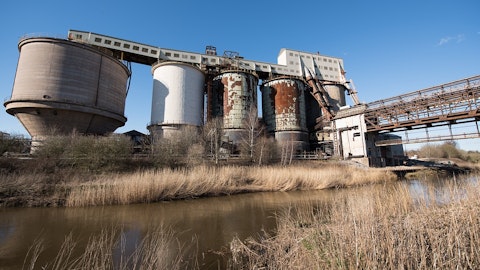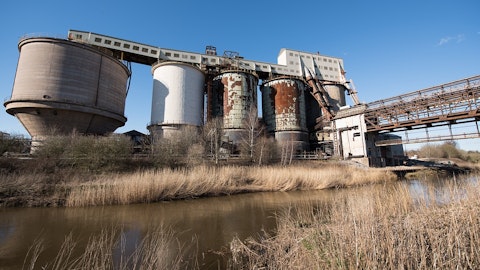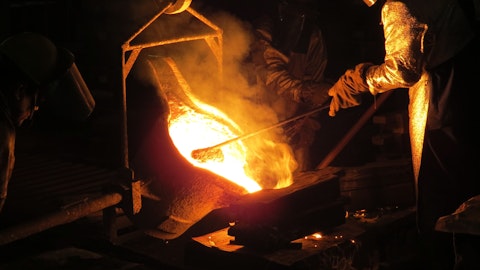John Srivisal: Yes, we’ve obviously guided 270 for this year. And as John mentioned, we expect in the mid-300s next year, not the levels that we had in 2022, but we do have flexibility even in that 350 number.
David Begleiter: Very good. Thank you.
Operator: Thank you. Our next question comes from the line of Josh Spector at UBS. Please go ahead. Your line is open.
Josh Spector: Yes. Hey, guys. Thanks for taking my question. And first, thanks JF, for all the contributions over the years and congrats, John. So I wanted to ask on the fourth quarter guidance, not on volumes, but on the EBITDA side. So if you see a 50% uptick in zircon, my math is that that kind of gets me to the top end of your guidance alone. So I’m just wondering within the other puts and takes, outside of TiO2 volumes, is there something else you’re assuming on price or is there some additional roll through of cost, because of the idle facility charges that ramps into fourth quarter and how would that progress into early next year?
John Srivisal: Yes. I think the key drivers of the range for our Q4 EBITDA guide is primarily commercial. So you’re right, Josh, that obviously pricing is going to play a part of it outside of the zircon volumes. As we’ve mentioned, we did have an outage at Botlek due to our supplier next door, and that’s really a driver as well. It’s $5 million in Q3. And so just depending on we expect it to get up in November 11 in a couple of days now – a couple of weeks now, but that may create some further burden depending on when that gets up.
John Romano: Yes. That’s a third-party provider of steam, which we need to actually finish the pigment there. So we believe and we have confidence in what they’ve been telling us on coming up on November the 11, but that’s definitely something that could create some sort of variance in that number.
Josh Spector: Okay, thanks. And just kind of looking into early next year, not necessarily anything volumes or price related, but more the cost side, I guess, with how you’re operating your mines. I guess, I just want to understand that you guys kind of changed how you operated mid this year. You’re taking more charges now as we look at you plan into next year. Does that burden increase or decrease on your EBITDA as we think about the first half next year versus second half this year?
John Srivisal: Yeah, I think one of the things we – the question that came earlier about working capital, the other issue that’s impacting working capital is also the cost of our inventory. So our costs have definitely gone up and it takes a little bit of time to work that through. So we’re still going to see – we’re going to be burdened with higher costs from the inventory that we have in the system as we make that high grade feedstock that openly goes into our TiO2 production. So it will take a little bit of time for that to work its way through the system. John, did you want to…
John Romano: No, that’s exactly the answer.
Josh Spector: Got it. All right, thanks guys.
Operator: Thank you. Our next question comes from the line of John McNulty at BMO Capital Markets. Please go ahead. Your line is open.
John McNulty: Yes, thanks for taking my question. Maybe just a follow-up to Josh’s call. So if – I think you said earlier that 3Q had about a $38 million hit tied to higher fixed cost absorption. And it seems like that’s something that’s going to continue to drag on. To your point, you’ve got high cost inventory to work through. Is this something that based on the higher inventory levels that you have on the ore front that can drag through most of 2024, or is that too draconian in terms of how we think about kind of the pressures that that high cost inventory and high fixed cost absorbed inventory works its way through the system. I guess, how should we be kind of gauging that as we look to next year?
John Romano: Yes, John, good question. And I’d say, through year end, we’d expect that cost to flow off in our results within the first four to five months of next year.
John Srivisal: And it’s not just feedstock, John, either. We’ve been pretty open about how we’re running our assets on the TiO2 side at 70% capacity utilization. So as we start to see the market picking up, we’ll start to ramp those plants back up and that fixed cost absorption from those finishing facilities will start to come down. And quite frankly, there are some assets that were already starting to move up in response to some of the things that we’re seeing, but we’re still running those assets well below full capacity.
John McNulty: Got it. Okay. No, that’s helpful. And then maybe just a little bit of color, I think you had mentioned in one of the responses just that – if you were actually starting to see some demand pull in Asia and it’s probably not demand driven, it’s more restock, it sounded like. But I guess do you have clarity or do you have much comfort in where inventory levels are in Asia or any of the major regions and how much below normal they may be at this point? Is there a way to kind of give us a little bit of color around that?
John Romano: Well, I think the simplest thing is that from our salespeople and the engagement that we have out with our customers, they do get out and have very – a lot of dialogue with customers around where inventory is. I think at the end of the day, there’s still pricing activity going on there. And when we start to pull back from requests to reduce price and customers continue ordering at the same levels that gives you an idea that you’re towards the end of what typically tends to be a downturn. So it’s our belief that customer destocking has run its course. Orders are picking up. I mean, even in China, we’re seeing orders picking up. That’s not because China has rebounded significantly, it’s because our inventories and the inventories inside the industry there have gotten to a low level, it’s not sustainable.
So I think there’s an element. I mean, India, for instance, India is still a very strong market for us. It’s an area where there’s a significant amount of Chinese exports that go into India, but our volumes into India are continuing to be strong, and it’s one of the bright spots.
John McNulty: Got it. Okay. Thanks for the color. And, JF, congratulations and enjoy the retirement for sure.
Jean-Francois Turgeon: Thank you, John.
Operator: Thank you. Our next question comes from the line of Frank Mitsch at Fermium Research. Please go ahead. Your line is open.


